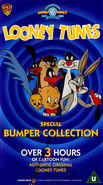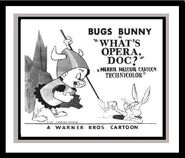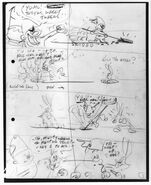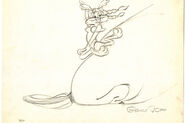What's Opera, Doc? is a 1957 Merrie Melodies short directed by Chuck Jones.
Title[]
The title is a play on Bugs Bunny's usual catchphrase, "what's up, Doc?"
Plot[]
The silhouette of a mighty Viking arouses ferocious lightning storms. It is Elmer Fudd (as the demigod Siegfried). Elmer sings his signature line, "Be vewy qwiet, I'm hunting wabbits" (in recitative), before arriving at Bugs Bunny's hole. Bugs watches Elmer fruitlessly jam his spear into the hole to say, "Kiww the wabbit! Kiww the wabbit! Kiww the wabbit!" Bugs sticks his head out of another rabbit hole and, apparently appalled, sings his signature line, "What's up, doc?" to the theme of Siegfried's horn call from the Ring Cycle. He then taunts Elmer about his "spear and magic helmet". This prompts a display of Elmer-as-Siegfried's "mighty powers", set to the overture of The Flying Dutchman. At that, Bugs flees and the chase begins.
Suddenly, Elmer is stopped in his tracks at the sight of the beautiful Valkyrie Brünnhilde (Bugs in an obvious disguise), riding grandly on an enormously fat horse. "Siegfried" and "Brünnhilde" exchange endearments, set to the overture to Tannhäuser:
- "Oh Bwunhilde, you'w so wuvwy!"
- "Yes I know it; I can't help it!"
- "Oh Bwunhilde, be my wove!"
and after the usual "hard to get" pursuit, they perform a short ballet based on the Venusberg ballet in Tannhäuser, capping it off with the duet "Return My Love," set to another section of the Tannhäuser overture. Bugs' true identity is suddenly exposed when his headdress falls off, enraging Elmer and prompting him to command fierce lightning, "typhoons, hurricanes, earthquakes," and, finally, "SMOG!!!" (a word Elmer screams that was not done by Bryan but by Blanc) to "kill da wabbit!" while music from The Valkyries plays in the background.
Eventually, a lightning bolt strikes Bugs dead. Upon seeing the bunny's corpse, a remorseful Elmer immediately regrets his wrath and tearfully carries the bunny off to the overture to Tannhäuser. Bugs suddenly raises his head and remarks, "Well, what did you expect in an opera? A happy ending?" before playing dead again.
Availability[]
The Looney Tunes Video Show Volume 15
A Salute to Chuck Jones
Elmer Fudd's Comedy Capers
Bugs Bunny (1990)
Looney Tunes Curtain Calls: Classic Music and Show Business Cartoons
Special Bumper Collection (Vol. 3)
Bugs Bunny
Elmer Fudd
Looney Tunes: The Collectors Edition Volume 5: Musical Masterpieces
Bugs Bunny (2003)
Looney Tunes Golden Collection Volume 2, Disc Four, with two optional audio commentaries, optional music-only and voice-only audio tracks, and accompanied by a making-of documentary entitled Wagnerian Wabbit
Looney Tunes Spotlight Collection: Volume 2 Disc 2
Looney Tunes Collection All Stars Volume 3
The Essential Bugs Bunny, Disc 1
Looney Tunes Platinum Collection: Volume 1, Disc One (remastered and HD)
Looney Tunes Platinum Collection: Volume 1, Disc One
Looney Tunes Showcase: Volume 1
Looney Tunes Spotlight Collection Volumes 2-3 Repack
Looney Tunes Musical Masterpieces (restored)
Music Triple Feature
Looney Tunes Spotlight Collection Volumes 1-3 Repack
Looney Tunes: Parodies Collection
Bugs Bunny 80th Anniversary Collection, Disc 2 (remastered and HD)
Streaming[]
Bugs Bunny Vol. 1, paired with "Bugs Bunny Gets the Boid"
Wagner's Music[]
When presented in the 1979 compilation The Bugs Bunny Road-Runner Movie, Bugs Bunny claims that the short was the whole of Wagner's seventeen-hour opera cycle "Der Ring des Nibelungen" (The Ring of the Nibelung, which he mispronounced as "The Rings of Nibble-lung" in his Brooklynese accent), condensed into only seven minutes. He also pronounced Richard Wagner the way it looks (wag-ner), instead of Rikard Vagner. Besides the second opera of Ring, Die Walküre (The Valkyrie) and the third opera of the Ring, Siegfried, other Wagnerian music present in the cartoon comes from Tannhäuser and Der fliegende Holländer (The Flying Dutchman). Specific excerpts include:
- the overture from The Flying Dutchman — opening storm scene
- Siegfried's horn call from Siegfried — "O mighty warrior of great fighting stock"
- the overture and "Pilgrims’ Chorus" from Tannhäuser — "O Bwünnhilde, you'w so wuvwy," "Return my love," and the closing scene
- the Bacchanal from Tannhäuser — ballet scene between Elmer and Bugs
Notes[]
- "What's Opera, Doc?" required about six times as much work and expense as any of the other six-minute cartoons his production unit was turning out at the time. Chuck Jones has admitted as much, having described a surreptitious re-allocation of production time to completing the short. The cartoons were scheduled for a five-week production, so to cover up for the extra time spent, Jones had his entire unit doctor their time cards to make it appear as if they were working on the Wile E. Coyote and Road Runner cartoon "Zoom and Bored" for two weeks before production of that cartoon actually started.[1]
- According to Chuck Jones, an 80-piece orchestra was used to score the cartoon "to keep Wagnerian opera’s sense of grandeur."[2]
- With a total of 104 cuts, the short has a larger variety of backgrounds than a normal six-minute cartoon.
- This cartoon is widely regarded not only as Chuck Jones’ greatest masterpiece, but many film critics, animation fans, and filmmakers consider this to be the greatest animation achievement of all the cartoons Warner Bros. released since this medium arose in 1930. It has topped many Top Ten lists of the greatest animated cartoons of all time. It was rated by a panel of over 1000 animators in Jerry Beck's 1994 book The 50 Greatest Cartoons: As Selected by 1,000 Animation Professionals as the #1 greatest cartoon of all time.[3] It was inducted by the Library of Congress in 1992 for the National Film Registry, presently preserving the 500 most important films of all time, and is the only short cartoon featuring Bugs Bunny on the list.[4]
- In 1992, it became the first cartoon short to be deemed "culturally, historically, or aesthetically significant" by the United States Library of Congress, and thus was selected for preservation in the National Film Registry. "Duck Amuck" and "One Froggy Evening" were also later inducted into the registry, making Chuck Jones the only animator with three shorts thus recognized. It is currently the only Bugs Bunny short listed in the National Film Registry, except for Bugs' cameo in "Duck Amuck".[4]
- The Michael Maltese story features Elmer Fudd chasing Bugs Bunny through a 6:11 opera tic parody of 19th century classical composer Richard Wagner's operas, particularly Der Ring des Nibelungen (The Ring of the Nibelung) and Tannhäuser. It is sometimes characterized as a condensed version of Wagner's Ring, and its music borrows heavily from the second opera Die Walküre, woven around the standard Bugs-Elmer conflict.
- Michael Maltese also wrote lyrics to Wagner's music to create the duet "Return My Love".
- The cartoon drew upon some previous Warner studio work; the concept of Bugs in Valkyrie drag riding a fat horse to the Tannhäuser Pilgrim's Chorus was originated by Friz Freleng in the suppressed 1945 wartime cartoon "Herr Meets Hare".
- This short was used in The Bugs Bunny Road-Runner Movie. Before the short, Bugs mentions how he loves opera so much and says that the next short with him and Elmer was one of the best cartoons he's ever been in.
- This cartoon was used in Bugs Bunny's Overtures to Disaster and then used as the final cartoon in the now special cartoon concert, Bugs Bunny on Broadway/Bugs Bunny at the Symphony.
- In Bugs Bunny and Taz: Time Busters, Fudd-as-Siegfried is the boss of the Viking level.
- A clip from the short was used in Animaniacs in the Slappy Squirrel segment, "Critical Condition".
- The fat horse Bugs rode as Brünnhilde would return in the musical sequence "We Are in Love" in The Looney Tunes Show, and in the opening theme of Tiny Toons Looniversity.
- This is the final Elmer Fudd short directed by Chuck Jones in the golden age of animation.
- This cartoon marks the third and final time that Elmer Fudd defeated Bugs Bunny; the other two were "Hare Brush" and "Rabbit Rampage", both from 1955.
Gallery[]
References[]
- ↑ Maltin, Leonard (1987). "Warner Bros.", Of Mice and Magic: A History of American Animated Cartoons. Plume Books, page 267. ISBN 978-0452259935.
- ↑ Goldmark, Daniel (2005). "What's Opera Doc? and Cartoon Opera", Tunes for 'Toons: Music and the Hollywood Cartoon. University of California Press, page 150. ISBN 978-0520253117.
- ↑ Beck, Jerry (1994). The 50 Greatest Cartoons: As Selected by 1,000 Animation Professionals. Turner Publishing, page 30–35. ISBN 978-1878685490.
- ↑ 4.0 4.1 Complete National Film Registry Listing. Retrieved on 2009-02-09.
Further reading[]
- Beck, Jerry and Friedwald, Will (1989): Looney Tunes and Merrie Melodies: A Complete Illustrated Guide to the Warner Bros. Cartoons. Henry Holt and Company.
- Richard Freedman, What's Opera, Doc?, Andante Magazine, March 2002
- Thomas, Todd and Barbara, "WHAT'S OPERA, DOC? -- An analysis of the various Richard Wagner operas used throughout the cartoon"
External links[]
- "What's Opera, Doc?" Analysis
- Andante Magazine article on "What's Opera, Doc?" and "Rabbit of Seville"
- "What's Opera, Doc?" at the SFX Resource

























































